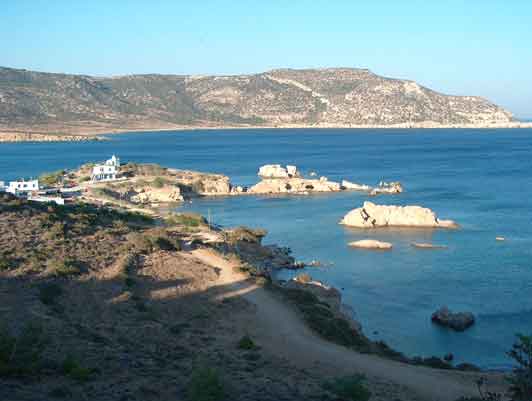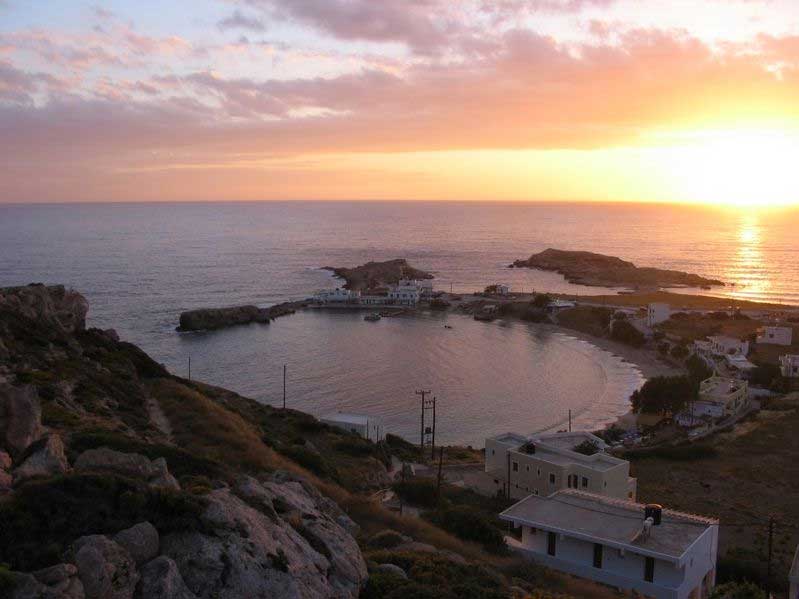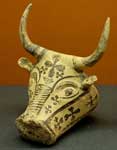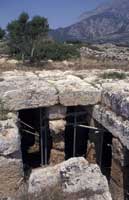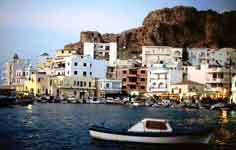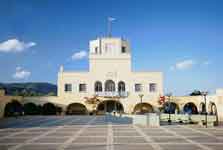.
Administrative Region : North Aegean
Regional unit : Karpathos
 |
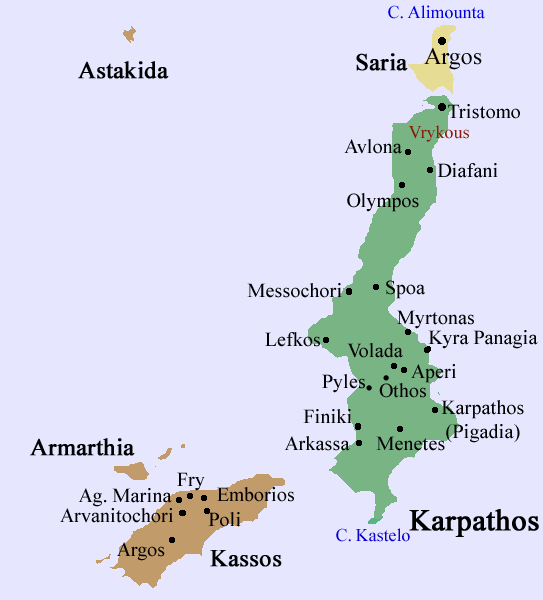 |
Karpathos (Greek: Κάρπαθος) is the second largest of the Greek Dodecanese islands, in the southeastern Aegean Sea. Together with the neighboring smaller Saria Island it forms the municipality Karpathos, which is part of the Karpathos regional unit. From its remote position Karpathos has preserved many peculiarities of dress, customs and dialect, the last resembling those of Crete and Cyprus. The island has also been called Latin: Carpathus, Italian: Scarpanto, Turkish: Kerpe.
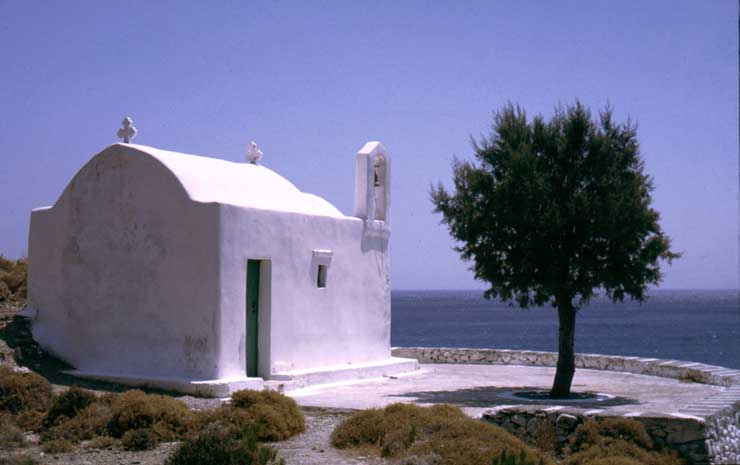
Small Church Dafni bay (Photo Robert Dycke)
Geography
Karpathos by Giacomo Franco (1597).
The community of Olympos.
The island is located about 47 kilometers southwest of Rhodes, in the part of the Mediterranean which is called, after it, the Carpathian Sea (Latin: Carpathium Mare). The Sea of Crete, a sub-basin of the Mediterranean Sea, has its eastern limit defined by the island of Karpathos.[1] Karpathos' highest point is Mt. Lastos, at 1,215 metres (3,986 ft). Karpathos comprises 10 villages. All villages preserve intensively the traditional style of the island. In the southeast of the island you can find Pigadia (official name Karpathos), capital and main port of the island. The capital is surrounded by the villages of Menetes, Arkasa, Aperi, Volada, Othos, and Pyles. In the North one can find Mesochori, Spoa and Olymbos the last village in the North of the island, of great folkloric and architectural interest. There are two ports in the island; one is in the town of Karpathos and the other in the north of the island next to Olympos named Diafani.
Levkos (Karpathos)
Apella beach, Karpathos
Climate
The weather station of Karpathos alongside Ierapetra holds Greece's highest annual mean temperature, 20.1°C (1950–1960, 1970–1975).[2]
Municipality
The present municipality Karpathos was formed at the 2011 local government reform by the merger of the following 2 former municipalities, that became municipal units:[3]
Karpathos
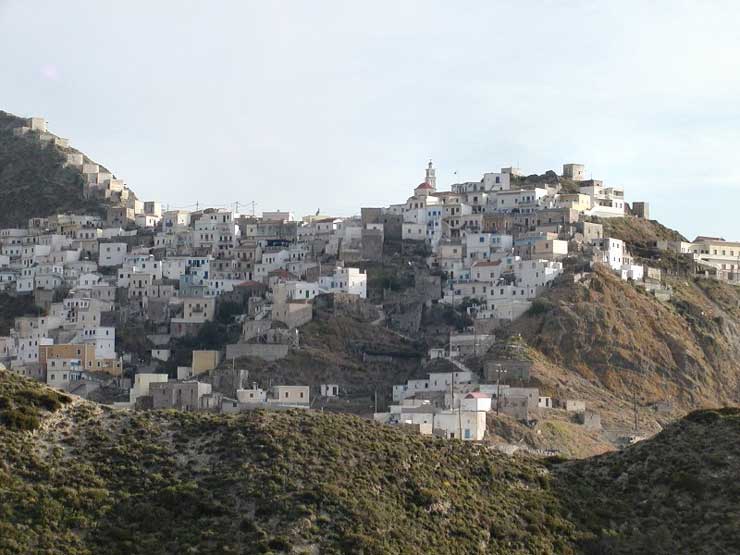
Ólympos Village , Karpathos (Source)
Olympos
History
The building of the district administration of the island in Pigadia
The island was both in ancient and medieval times closely connected with Rhodes. Its current name is mentioned, with a slight shift of one letter, in Homer's Iliad as Krapathos (οἳ δ' ἄρα Νίσυρόν τ' εἶχον Κράπαθόν τε Κάσον τε). Besides, the island is mentioned by Virgil, Pliny the Elder and Strabo. Karpathians fought with Sparta in the Peloponnesian War in 431 BC and lost their independence to Rhodes in 400 BC. In 42 BC the island fell to Rome. After the division of the roman Empire the island joined the Byzantine Empire. By 1304 Karpathos was given as fief by the Emperor to the Genoese corsairs Andrea and Lodovico Moresco, but in 1306 it fell under Andrea Cornaro, a member of the noble Venetian Cornaro family.[4] The Cornaro controlled Karpathos until 1538, when it finally passed into the possession of the Ottoman Turks. Under the Ottomans the island decayed deeply.[4]
In the years 1821-22, during the Greek War of Independence, the island could free itself, but afterward it fell again under the Ottoman rule.[4] In 1835 Sultan Mahmud II conceded to the island the privilege of the Maktu tax system, that is its tax burden was calculated as an annual lump sum, and not on an household basis.[4] The Ottoman rule ended on May 12, 1912, when the Italians conquered the island, together with the whole Dodecanese, during the Italo-Turkish War of 1911-12. On that day sailors of the Regia Marina ship Vittorio Emanuele and the destroyer Alpino landed in Karpathos.[4] With the Treaty of Lausanne of 1923 Karpathos joined the other islands of the Dodecanese in the Italian possession of the Isole Italiane dell'Egeo,[4] and was ceded by Italy to Greece with the Paris Peace Treaties of 1947. The island formally joined the Greek State on 7 March 1948, together with the other Dodecanese islands.
Despite such a scattered past, the last half century has been pivotal in the development of the island's character. A war-ravaged economy sent many a Karpathian to the U.S. eastern seaboard cities; Karpathos today has a significant Greek-American constituency who have returned to their beloved island and invested heavily. As a result, Pigadia and other towns successfully infuse modern elements into a traditional setting. In the mountains to the north, a world unto itself, residents preserve tradition almost religiously.
Transportation
Karpathos Island National Airport, with its relatively large runway, is located on the south side (Afiartis area). Karpathos is connected to neighboring islands and to the mainland via ferries and airplanes. The ferries provide transport to and from Piraeus (via Crete and Rhodes). Scheduled domestic flights connect the island with Rhodes, Kasos, Crete and Athens daily. Additionally, charter flights from various European cities are frequently scheduled during the high season (April–October).
Within the island, cars are the preferred mode of transportation. The port, the airport, the main villages and other popular locations are connected by an adequate system of municipal roads, most of which are paved. During the summer months, small private boats depart from Pigadia to various locations daily, including Olympos (via Diafani) and some inaccessible beaches. Fixed-rate taxis (agoraia) and municipal buses are also available all year long.
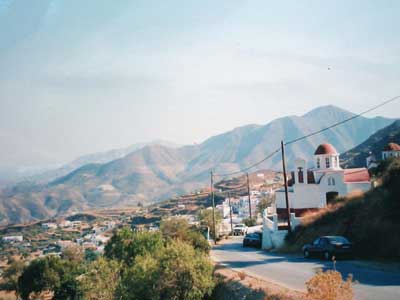
Karpathos , Photo: M.Minderhoud, 1997 (Source)
Population
The island's 2001 census population was 6,511 inhabitants. This number more than doubles in the summer months as many Karpathian expatriates come to the island for their vacation with their families. Also, taking into consideration the number of tourists that visit, there can be up to 20,000 people on the island during the summer months. The population density is greatest during the 15th of August due to the Panagias festival (Assumption of Mary), which is considered the most important festival on the island. Individuals travel from around the world to attend the festival and view the many traditions that still remain on the island.
Beaches
The beaches of Karpathos island can be divided into four large groups: the beaches on the east coast are smaller and gravelly but without wind; the beaches of the southern part of the island, near the airport, area made of fine white sand; the sandy beach on the west coast are the most exposed to the Meltemi and they are only available in low wind conditions; the beaches of the north of the island, accessible only by sea and partly by a jeep.
East Coast - Amoopi, Karpathos Beach, Achata, Kato Latos (reachable only by foot), Apella.
South Coast - Damatria, Diakoftis, Devils Bay, Agriopotamos (nude beach).
West Coast - Finiki, Arkasa Leucadius.
North Coast - Diafani, Vananda, Forokli
Municipality Karpathos(Seat: Κάρπαθος (πόλη), η , Historic Seat: Όλυμπος Καρπάθου, ο) |
|---|
| Municipal unit Karpathos |
| Municipal Community Karpathos |
| Afoti (Άφωτη Καρπάθου, η (νησίδα)) |
| Gaidouronisi (Γαϊδουρονήσι Καρπάθου, το (νησίδα)) |
| Despotiko (Δεσποτικό Καρπάθου, το (νησίδα)) |
| Κάρπαθος (πόλη), η |
| Platyolo (Πλατύολο Καρπάθου, το) |
| Community Aperi |
| Aperi (Απέρι Καρπάθου, το) |
| Katodio (Κατώδιο Καρπάθου, το) |
| Kyra Panagia (Κυρά Παναγιά Καρπάθου, η) |
| Myrtonas (Μυρτώνας Καρπάθου, ο) |
| Community Arkasa |
| Arkasa (Αρκάσα Καρπάθου, η) |
| Diakoftis (Διακόφτης Καρπάθου, ο (νησίδα)) |
| Foiniki (Φοινίκι Καρπάθου, το) |
| Charkias (αΧρκιάς Καρπάθου, ο (νησίδα)) |
| Community Volada |
| Volada (Βωλάδα Καρπάθου, η) |
| Λάστος Καρπάθου, η |
| Community Menetes |
| Άγιος Ιωάννης Αφιάρτη Καρπάθου, ο |
| Κήπος Αφιάρτη Καρπάθου, ο |
| Lakki (Λακκί Καρπάθου, το) |
| Menetes (Μενετές Καρπάθου, οι) |
| Moira (Μοίρα Καρπάθου, η (νησίδα)) |
| Nisieros (Νισιερός Καρπάθου, ο (νησίδα)) |
| Prasonisi (Πρασονήσι Καρπάθου, το (νησίδα)) |
| Community Mesochori |
| Kato Lefkos (Κάτω Λευκός Καρπάθου, ο) |
| Lefkos (Λευκός Καρπάθου, ο) |
| Mesochori (Μεσοχώρι Καρπάθου, το) |
| Nisi (Νησί Καρπάθου, το (νησίδα)) |
| Sokastro (Σώκαστρο Καρπάθου, το (νησίδα)) |
| Community Othos |
| Kallenes (Κάλλενες Καρπάθου, οι) |
| Othos (Όθος Καρπάθου, το) |
| Stes (Στες Καρπάθου, οι) |
| Community Pyles |
| Pyles (Πυλές Καρπάθου, οι) |
| Community Spoa |
| Agios Nikolaos (Άγιος Νικόλαος Καρπάθου, ο) |
| Spoa (Σπόα Καρπάθου, τα) |
| Municipal unit Olympos |
| Community Olympos |
| Astakida (Αστακίδα Καρπάθου, η (νησίδα)) |
| Atsakidopoulo (Ατσακιδόπουλο Καρπάθου, το (νησίδα)) |
| Avlona (Αυλώνα Καρπάθου, η)) |
| Diafani (Διαφάνι Καρπάθου, το) |
| Divounia (Διβούνια Καρπάθου, τα (νησίδα)) |
| Olympos (Όλυμπος Καρπάθου, ο) |
| Saria (Σαριά Καρπάθου, η (νησίδα)) |
| Tristomo (Τρίστομο Καρπάθου, το)) |
| Chamili (Χαμηλή Καρπάθου, η (νησίδα)) |
See also
List of traditional Greek place names
Sources
Bertarelli, L.V. (1929). Guida d'Italia, Vol. XVII. Consociazione Turistica Italiana, Milano.
Notes
^ * Peter Saundry, C.Michael Hogan & Steve Baum. 2011. Sea of Crete. Encyclopedia of Earth. Eds.M.Pidwirny & C.J.Cleveland. National Council for Science and Environment. Washington DC.
^ "The Climate of Magouliana of Arcadia". The Climate of Magouliana of Arcadia (in Greek). See table 4, page 19. Academy of Athens, Research centre for Atmospheric Physics and Climatology. Retrieved 2011-02-15.
^ Kallikratis law Greece Ministry of Interior (Greek)
^ a b c d e f Bertarelli, 137
External links
Everything about our island
Ιndependent website for North Karpathos
Karpathian Association Australia
Tourism official site of Karpathos
Karpathos Photogallery
|
The Dodecanese Islands Agathonissi | Koubelonisi | Stroggyli | Farmakonisi | Arkoi | Kalovolos | Agreloussa | Anydros Patmou | Patmos | Hiliomodi Patmou | Tragonisi | Arefoussa | Leipsoi | Megalo Aspronisi Leipson | Makry Aspronisi Leipson | Kouloura Leipson | Makronisi Leipson | Halavra | Imia | Fragos | Arhangelos | Faradonesia | Leros | Piganoussa | Pitta | Megalo Glaronisi | Mikro Glaronisi | Kalymnos | Kalolimnos | Kalavros Kalymnou | Telendos | Nero | Safonidi | Plati Pserimou | Pserimos | Levitha | Mavra Levithas | Glaros Kinarou | Kinaros | Kos | Gyali | Nisyros | Pergoussa | Paheia Nisyrou | Kandeloussa | Tilos | Antitilos | Gaidourosnissi Tilou | Seirina | Mesonisi Seirinas | Adelfoi Syrnas Islets | Kounoupoi | Koutsomytis | Hondro | Astypalaia | Fokionissia | Pontikoussa | Symi | Nimos | Marmaras | Kouloundros | Plati Symis | Sesklio | Chalki | Agioi Theodoroi Halkis | Alimia | Makry Halkis | Prasouda | Rhodos | Strogulli Kritinias | Htenies | Karavolas Rodhou | Prasonissi Rodhou | Megalo Sofrano | Mikro Sofrano | Astakida | Kamilonisi | Saria | Karpathos | Kasos | Armathia | Makronissi Kassou | Rho | Kastellorizo (Megisti) | Stroggyli Kastellorizou |
| Ancient Greece
Science, Technology , Medicine , Warfare, , Biographies , Life , Cities/Places/Maps , Arts , Literature , Philosophy ,Olympics, Mythology , History , Images Medieval Greece / Byzantine Empire Science, Technology, Arts, , Warfare , Literature, Biographies, Icons, History Modern Greece Cities, Islands, Regions, Fauna/Flora ,Biographies , History , Warfare, Science/Technology, Literature, Music , Arts , Film/Actors , Sport , Fashion --- |
Retrieved from "http://en.wikipedia.org/"
All text is available under the terms of the GNU Free Documentation License


